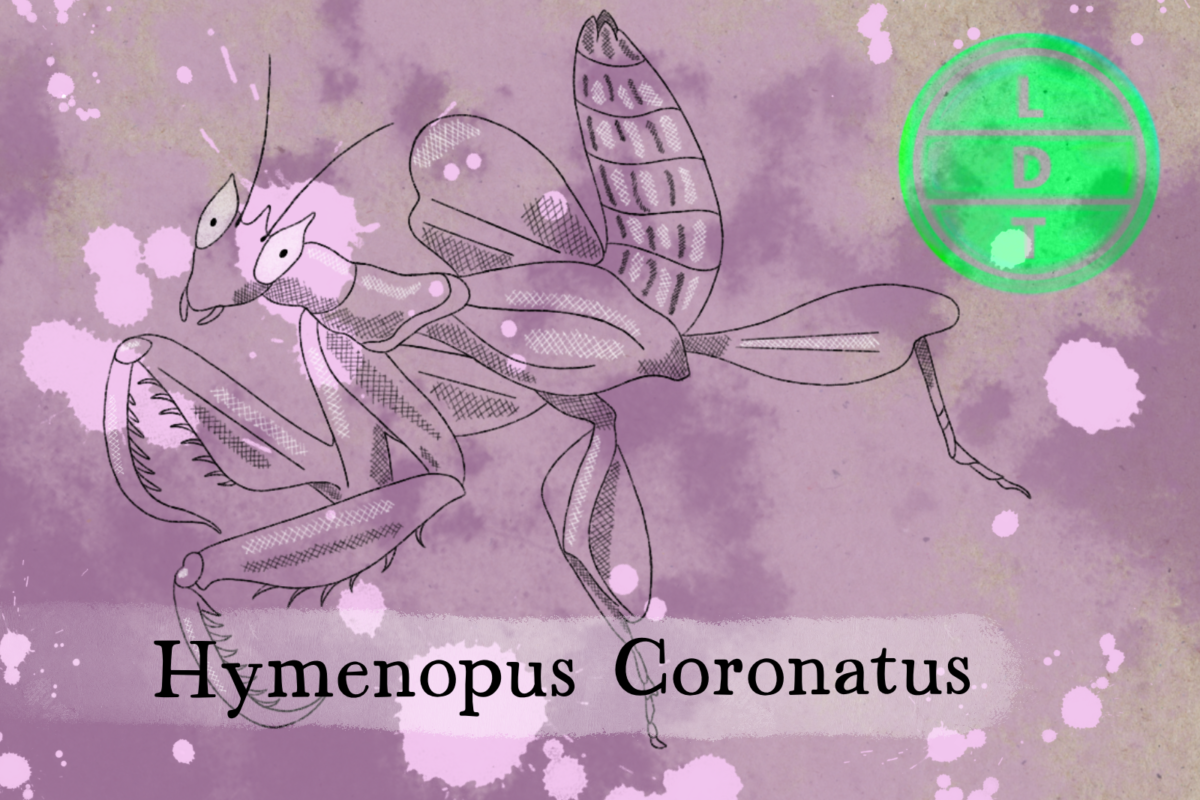“…and today we’re talking about a bug that engages in more aggressive mimicry than a middle schooler repeating everything you’re saying. But more on that later.”
The year was 1879. James Hingsley was an Australian journalist who returned from his voyage to Indonesia with a strange tale on his lips. He claimed that the northern islands were populated with an evil flower that captured insects and devoured them whole. Is this a lie? A trick? An evil curse? Or a little shop of horrors plant? By no means! It’s just the work of one devout little insect known as the orchid mantis. But sometimes blending in means standing out here in Life, Death, and Taxonomy.
Description of the Orchid Mantis
- The orchid mantis is a small colorful mantis.
- It diverges from the typical leaf greek color to be mostly white and pink.
- Their heads are shaped like a typical mantis, but make it a lot more aquiline.
- Their eyes come to points at the top of their heads, and taper down like a V-shape to their mouth parts.
- Like other mantises, they have four walking legs and a pair of spiked legs for catching prey.
Measure Up
Welcome to the beloved Measure Up segment. The official listener’s favorite part of the show! The part of the show when we present the animal’s size and dimension in relatable terms through a quiz that’s fun for the whole family. It’s also the part of the show that’s introduced by you when you send in audio of yourself saying, singing, or chittering the words Measure Up into ldtaxonomy at Gmail dot com. We don’t have a new Measure Up intro.
Female Length
- 2.5 inches (63 mm)
- How many orchid mantises go into the height of the tallest orchid?
- Hint: The Pseudovanilla foliata is called the great climbing orchid because it is not freestanding, and instead climbs structures like trees.
- 235.2 mantises.The great climbing orchid has been recorded climbing 15m (49 ft).
Male Length
- 1 inch (25.4 mm)
- How many of the smallest flowering plants in the world go into the length of a male orchid mantis?
- Hint: The smallest flowering plant is Wolffia globosa, also called duckweed and Asian watermeal. It grows on the surface of calm bodies of water. If you take some in your hand, it looks like slime until you look closer and see individual green pods. It can be eaten, and it’s integrated into a lot of Asian cuisine.
- 125 duckweed plants. The plant can be 0.1–0.2 mm (0.004–0.008 in) in diameter.
Fast Facts
The orchid mantis is native to Southeast Asia and prefers rainforests.
Like most mantises, it is carnivorous. In labs it seems to prefer butterflies and moths. However, it is specially designed to catch flies.
It has a dark colored dot at the back of its abdomen that looks like a happy little fly, but only to a fly.
The orchid mantis is sometimes a cannibal and may eat its own–even its own siblings.
Major Fact: Flower Power
The year was 1879. James Hingsley was an Australian journalist who returned from his voyage to Indonesia with a strange tale on his lips. He claimed that the northern islands were populated with an evil flower that captured insects and devoured them whole. We’ve covered a few of nature’s greatest mimics on this show.
Some animals use mimicry to avoid predators; others use it to be predators. The orchid mantis uses it for both.
It uses a tactic called “aggressive mimicry.”
Actually, aggressive mimicry is using camouflage to stand out rather than blend in. Most of the time, camo is used so that other things (prey or predator) don’t see you. For prey, they want predators to leave them alone, and for predators, they want prey not to run away.
But with aggressive mimicry, the mimic-er wants its prey to notice it but not recognize it. This is like the wriggle worm tongue of a snapping turtle or the glowing lure on a female anglerfish – they want to be found.
So turns out, that when you love to eat bugs, looking like a flower definitely has its perks. The mantis will find orchids and climb up and down different stalks to find the ones that have flowers.
Once they do, they’ll clutch the stalk close to the flowers and sway with the breeze to mimic the buds. They also wiggle the little black dot on the end of their abdomen.
This acts as a lure since it looks like a fly to other flies. However, their main prey is pollinating insects like bees, wasps, butterflies, and moths.
They land on the flower thinking that they’re just gonna do a little pollinating – maybe sip a bit of that sweet, sweet nectar and then BAM. They’re caught in the elbow jaws of a hungry mantis. Their arms are lined with inward-facing spines that lock prey in place once they’ve been full-nelsoned.
But they don’t always need to be around flowers to make this work. In fact, researchers have found that they actually work better than real orchids.
This is because orchids tend to only be pollinated by a limited number of insects. One type of orchid only attracts male bees of one particular species.
So if the mantis mimics one specific orchid, it’s drastically limiting the number of insects that will fall into its trap.
Instead, the mantis has more of a general orchid disguise, allowing it to get a B+ rating for multiple orchids rather than an A+ for just one. This means that more different kinds of insects will see a great pollination opportunity.
Ending: So pick a pretty flower, hold on tight, and slap your favorite bugs out of the sky like the orchid mantis here in LDT.

